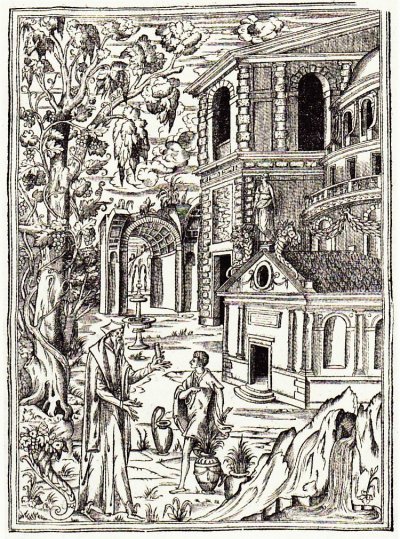De l’Orme’s Architectural Allegories
August 5th, 2007
Two woodcuts from Philibert de l’Orme‘s The first volume of architecture (Le premier tome de l’architecture), 1567, as reproduced in Taschen’s Architectural Theory.

“The bad [architect] wanders bereft of hands and eyes through a barren landscape with a Medieval castle” (p131).

“By contrast, the good architect stands in a flourishing garden, has many hands, is surrounded by Classical and new buildings alike, and is familiarizing young people with his scientific discipline” (p131).
The Etchings of Piranesi
March 3rd, 2007
Three etchings by the antiquarian artist Giovanni Battista Piranesi (1720—1778), reprinted in Luigi Ficacci’s Taschen edition.
Remains of the tomb of the Metelli. Click image to view larger version.
“When he can devote himself exclusively to ancient Romain remains, his style fully realizes the visionary originality that… he dedicated to representation of the ancient monuments” (p22).
View of the subterranean foundation of the mausoleum. Click image to view larger version.
“His prints ‘showed’ things in an unprecedented and unimaginable way… [they] revealed a previously unknown aspect and represented a totally unknown world that, notwithstanding the precision of his rendering, was loaded with an extraordinary forceful charge of information” (p8).
Tomb of the three Curatii brothers in Albano. Click image to view larger version.
“Over the course of their formal evolution, a forest of new content appeared — cryptic, symbolic, allegorical and synthesized into an extremely pictorial vision that could simultaneously appear to be a decorative whim or a mine of recondite meanings, while the initial subject, neutral in itself, was transformed into a composition. This was a game of intentional ambiguities that could function differently according to the disposition and critical capacity of the observer himself” (p24/5).


